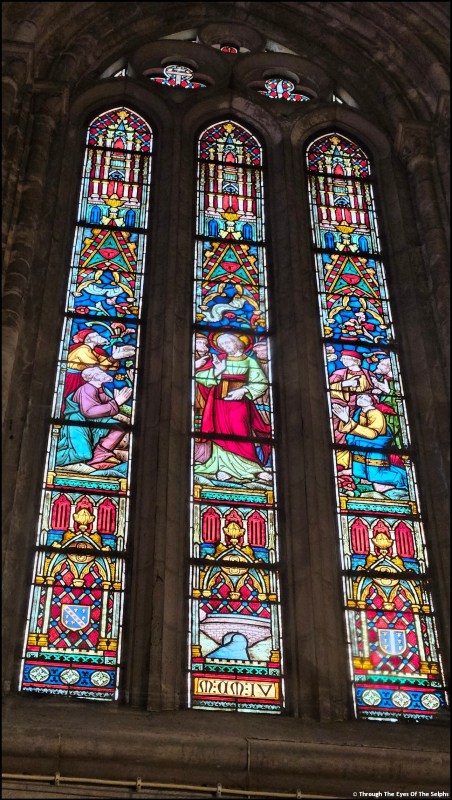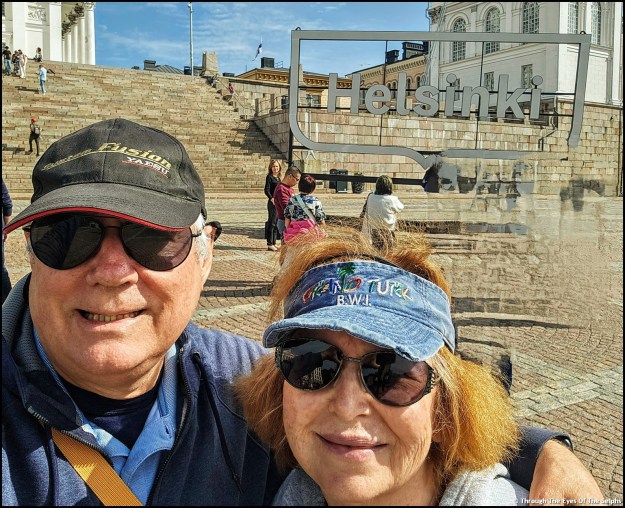Lisbon has many beautiful and interesting places to visit. We decided the best strategy was to buy the 48 hour Hop On Hop Off bus. What we didn’t know was how much the long waits for the trolleys and buses would really slow us down. Another complication was due to it being high tourist season, the lines to get into many places were ridiculously long, often in the hot sun. So we could only do what we had the time and energy to do.
The Lisbon Cathedral is Roman Catholic and the oldest church in the city. Built in 1147, it has survived many earthquakes and been renovated several times. It suffered major damage during the 1755 earthquake and underwent a major renovation at that time. There was a small entrance fee of five euros.





Inside were several Gothic tombs from the mid 14th century.

Tomb of María de Villalobos, wife of Lopo Fernandes Pacheco
Up a steep flight of stairs was the treasury with national ancient jewels and relics. Picture taking was not allowed and there were security people watching over everything.
Another church, possibly our favorite, was the Estrela Basilica. We went in there on a whim while we had time waiting for the next bus. Queen Maria I of Portugal ordered it built as a fulfillment of a vow she made to the Sacred Heart of Jesus. It is the first church in the world dedicated to the Sacred Heart of Jesus, one of the most well known and practiced Catholic devotions. The church was constructed from 1779 to 1789.








We went into the National Pantheon which turned out to be a bit of a disappointment. Built in the 17th century, it was originally the Church of Santa Engracia and was converted into the National Parthenon in 1916. The inside was not nearly as beautiful and elaborate as we expected. Many famous people are entombed here including Presidents, famous singers, writers and sports athletes. Of most interest to us were the tombs of explorers Vasco de Gama and Henry the Navigator. 


Belem Tower, also called the Tower of Saint Vincent, is a 16th century fortification built along the Tagus River. It was the point of embarkation and disembarkation for Portuguese explorers and was considered the ceremonial gateway to Lisbon. Constructed of limestone, it has a bastion and a 100 foot four story tower. We wanted to go inside and climb up the tower, but the line of people waiting in the hot sun was very long. A tourist sign updating people said the current wait was one hour. 
Nearby was the Monument of the Discoveries, built between 1958-1960. The monument celebrates the Portuguese Age of Discovery during the 15th and 16th centuries. 

Here are many monuments we saw during our visit.

King Dom Joseph I (1714 – 1777)

Sebastião José de Carvalho e Melo, Marquês de Pombal (1699 – 1782) Secretary of State for the Kingdom

King John I (1357–1433)

The Great Heroes War Memorial

Afonso de Albuquerque (1453 – 1515), 1st Duke of Goa, Portuguese general, admiral, and statesman
On July 12th, an Uber was promptly waiting at our door at 6:45 A.M. for our ride to the airport. The Lisbon airport could teach other airports about efficiency. We quickly checked into Air Portugal and dropped off our bags, went through security and passport control, and still had plenty of time for a leisurely breakfast. Well done, Lisbon! Our nine hour flight to Miami was uneventful. We had one meal and one snack that were both truly awful, but at least they gave us food and drink. Either no food or bad food was what we found on all our flights this year, including our flights to and from Israel in the early spring.
After the scary landing in Lisbon, I was apprehensive about this landing but all went well. Looking out the window of the plane, we were happy to see Miami, a little fuzzy with the hot, humid weather. 
After collecting our luggage we went through passport control where a friendly official welcomed us home. We picked up our rental car for the five hour drive home. Miami is definitely not our favorite place to drive home from. It was good to be home!
Thanks for following along with our travels. We had a wonderful time, visited many beautiful and interesting places, saw amazing scenery (especially in Norway) and met many kind people along the way.
We don’t have any trips on the horizon, but we have many places still on our very full bucket list.
See you next time!
Bill and Diane




































































































